This was published 5 years ago
Sicily, Italy: A toast to a unique history, food and culture
By Nicholas Whitlam
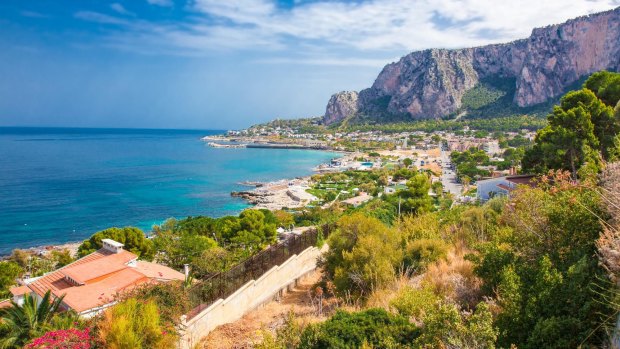
Mondello bay in Palermo.
Sicily is not Italy. Sicilians are the first to tell you so; it's their history, their food, their lifestyle, attitudes and culture. To them Italy and Sicily are separate.
The separation is established by the strait of Messina, that tight waterway between the mainland and the island of Sicily. So while most tourists will these days arrive at Sicily's two international airports – Palermo in the north-east or Catania in the east – a good way to understand the island's separateness is to cross the strait by train. Yes, a boat train. In an exciting logistical exercise your train is shunted onto a special vessel where it rests on tracks in the boat's bowels until shunted off on the other side; if the train is too long, they cut it in half and there is an extra set of shunts. Most passengers go up onto the vessel's decks to appreciate the famous channel.
It takes about 40 minutes to cross the strait, where wild whirlpools can challenge almost any sailor. And students of the ancients can imagine the competing horrors of Scylla and Charybdis.
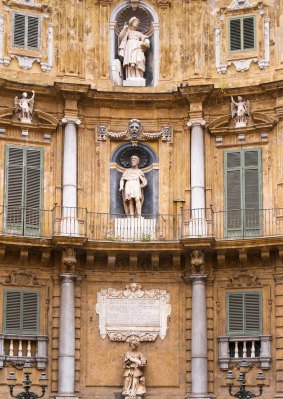
Statue of The Quattro Canti, or piazza Villena, is the name of an octagonal square in the historic center of Palermo with beautiful decorations of the buildings of 1606.Credit: Shutterstock
Mussolini is not back, but the trains do run on time again in Italy (and indeed in Sicily). In a full day you can get to or from Rome and Palermo, Siracusa, Taormina and points in between. The local train – running to and from Naples – is comfortable but catering is limited and it's best to take your own picnic, and the fast train between Roma and Naples is very comfortable indeed.
Unlike the Norman conquest of England in 1066, the Normans' contemporaneous conquest of Sicily took fully 30 years. But it produced the most glorious civilisation. Drawing from the disruption of the Great Schism between Constantinople and Rome, the Norman rulers of Sicily had access to the greatest artists of Italy and Byzantium, and Palermo with its intelligent rulers made them all welcome. There was no ethnic cleansing when the Normans took over from the Arabs; they took on the best of all worlds. Roger II, an attractive polymath, was the great example of this synthesis: a Latin Christian, he spoke Arabic and Greek, French and Italian, tolerated all faiths and wore Arab dress at court. Roger died at 59 in 1154, a century after the Schism. His Palatina chapel, built in the Royal Palace of Palermo, a rich mixture of Arabic, Byzantine and Norman influences, is truly one of the most beautiful rooms in the world.
It had taken nearly two millennia for Palermo to reach this apex of civilisation. Phoenicians had arrived in the eighth century BC, attracted by the magnificent bay surrounded by mountains and fertile land. Greeks followed, then Romans and Carthaginians who fought over it, before – with the spread of Islam – a relatively settled Arab domination was established from about 800 AD. And then came the Normans who embraced many of the established Islamic and Byzantine traditions
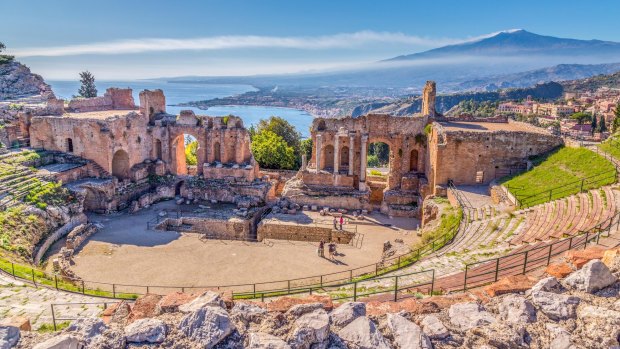
Ruins of the Ancient Greek Theater in Taormina.Credit: Shutterstock
It is not a pretty city today. Do not judge a book by its cover. Beauty lies behind the gates of buildings, medieval and more recent: a step into many a 16th or 17th century villa will evoke some of the luxury, self-satisfaction, glory and continuity of Lampedusa's The Leopard. The Duomo is Norman, and many churches – and there are many – have been created out of mosques.
To get a purchase on the Bay of Palermo and to understand its attraction over the centuries, you need to get out a little. Go up into the hills to Monreale or take a bus or taxi north to the resort town of Mondello, set underneath Mt Pellegrino and Mt Gallo. Or, to get another aspect of the bay's historic appeal, take the short trip from the city centre for a drink at the five-star Villa Igiea hotel (where the appalling Guilio Andreotti, many times prime minister and seemingly a statesman so far as most knew, would often meet his Mafia contacts).
Treasures, often hidden, abound throughout Palermo. It was, after all, the wealthiest and largest city in Europe for centuries – and, despite the grunge, it still prospers. Much can be enjoyed by the independent traveller, such as the 19th century Teatro Massimo that has near perfect acoustics, but most travellers would do best to hire a guide or join a group in order to optimise logistics and access. A good way to get the buzz of it all is to head straight for the Quattro Canti, the crossroads at the centre of Palermo, where the Bisso Bistrot – a testament to survival despite past Mafia standovers – serves brilliant food at reasonable prices.
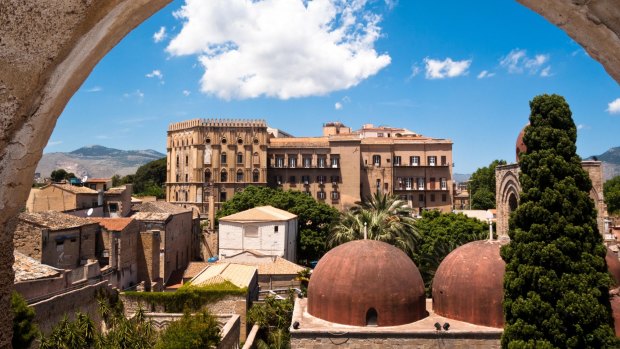
The Norman palace and San Giovanni Eremiti domes. Credit: Shutterstock
It was a fight between church and state that created the new cathedral at Monreale, up in the hills 15 kilometres south of Palermo. An uppity archbishop of Palermo, supported by the Pope, was challenging the authority of the king – so William II, Roger II's grandson, simply reactivated an archbishopric that had existed outside the city while the Arabs had been the dominant power, and a created what many have designated "the most beautiful church in the world". Christ Pantocrator – where Christ's human and divine sides are presented in a stylised image of face and hands – dominates the cathedral's heart (as similar images do in many Norman churches), but it is the exquisite Byzantine artwork here that attracts and endures.
The church is decorated in gold mosaics, from floor to ceiling, each section telling a story from the scriptures or celebrating a saint, an icon and/or the Norman monarchs. The affect is incredible. Separately, the cloister of the adjacent Benedictine abbey hosts hundreds of marble columns, highly decorated with individual capitals, with an Arabesque (Islamic) fountain in one corner – and it is worth a trip in itself.
There is a reason why those grand coastal temples sit high on the hills by the ancient Greek cities of Agrigento, Selinunte and Segesta. Once the Greeks had colonised their new settlements in the centuries before Christ, once they had ingratiated themselves with the locals and prospered, they wanted to celebrate their wealth and power. And temples or an array of temples told passing sailors that this was a city of consequence, that it should be respected, even feared. Of course when a great power, such as Carthage, took them on and won, the victors would invariably destroy a temple or two. And when the city recovered, however long it might take, often decades, it would rebuild a temple – if possible grander than its predecessor.
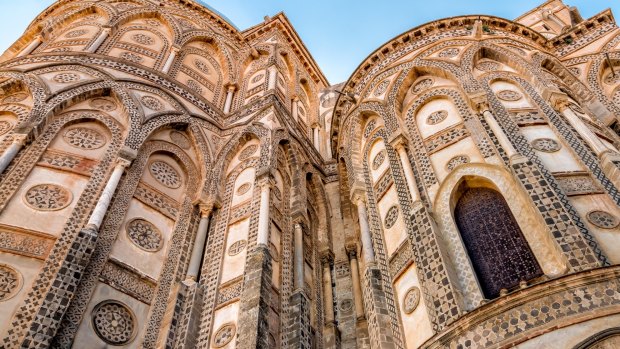
The ancient Cathedral Church in Monreale, Sicily.Credit: Shutterstock
Selinunte has an attractive small resort, Marinella, near its extensive ruins. Segesta is easily reached from Palermo, but Agrigento is really near nothing else and, although there is public transport throughout the island, a car or a tour group will be more reliable for a visit. So too for Piazza Armerina, the site of the splendid Villa Romana del Casale.
The remains of this villa are home to the most extensive and beautiful Roman-era floor mosaics still in existence. Occupied for about 150 years and built for an important person, perhaps an emperor or provincial governor, the exquisite artworks feature hunting and fishing, the most exotic wild animals and even "bikini"-clad dancing girls. Tesserae are the individual tiles that make up a mosaic. In this villa they are so small that it has been estimated that no less than 36,000 tesserae were used per square metre!
Holidaymakers come to Sicily for the sun and the food. If you are coming for the sun move slowly in July and August because it is really hot and humid. It is for this reason that many, like Giorgio Armani and other fashionistas seek out the sea breezes in the sometimes severe-looking Aeolian islands just to the north. And the food is terrific: fish and seafood of all types feature, plus pasta (of course), the local speciality caponata – that sweet, savoury and sour combination of eggplant, tomato and black olives – chickpea snacks, lemons, almonds, pistachios and capers. The local wine is plentiful and varies from great to indifferent. Sicily is famous for its fresh gelato (which has its origin in the Arabic expertise with ice and sugar) as well as Sicily's own invention, cassata. Some find the ricotta-based desserts, like cannoli, just too sweet; most love it. Foodies swear by the produce in and around the small cities of Ragusa, Modica and Noto in the south-east.
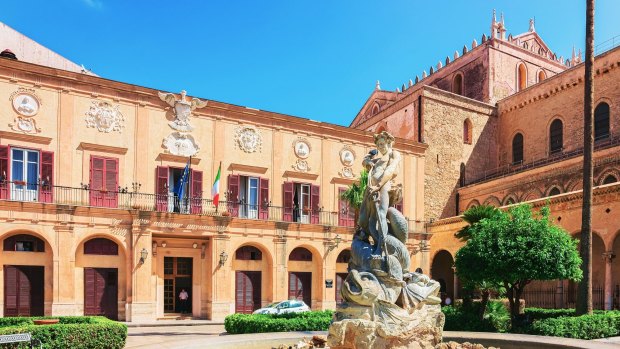
Street view with Monreale Cathedral, Palermo province, Sicily, Italy Credit: Shutterstock
And it is in the south-east that one finds the sybaritic city of Syracuse. Founded by Greeks from Corinth in 733 BC, and centred on the just-offshore island of Ortigia, it came to rival Athens as the largest and most powerful of Greek cities. Romans followed the Greeks and the huge pagan temple to Athena provides the foundations (and walls) for the city's cathedral on Ortigia's main square – with a Byzantine interior and a Baroque exterior. Once again, Sicily synthesised and accommodated its heritage. The Roman amphitheatre on the edge of town is largely intact and the Greek theatre, developed from the sixth BC on, stages Greek tragedies and modern pop concerts throughout the summer.
Taormina, up the east coast from Syracuse, on the way to Messina, is one of Italy's great attractions. Set on a dramatic mountain spur and overlooking the Bay of Naxos (where the first Greek settlement was established in 734 BC, just before Syracuse), Taormina has attracted the rich, famous and beautiful for the last 200 years: Wagner, Sibelius, the entire dolce vita cast from the 1950s and '60s, DH Lawrence and Frieda, Goethe, various lotus eaters, Kaiser Wilhelm, King Edward VII, you name it. There are the most terrific hotels, notably the Grand Hotel Timeo and the San Domenico (presently being refurbished, although its Michelin-starred restaurant is now open), with the family-owned four star Hotel Villa Belvedere as good a hotel as you will find anywhere.
Good restaurants flourish with high but fair prices, the young and beautiful, the rich and famous – and just regular folks too – all enjoy this spectacular place with its year-round temperate climate. The Greek theatre, fully redeveloped by the Romans, enjoys a spectacular site – the still-active Mount Etna sits on the horizon – and has performances all summer with wonderful acoustics. The public gardens, developed by an eccentric Englishwoman on a site near the centre of town with a grand ocean view, provide a restful alternative to all the excitement of the town. Local speciality shops for ceramics, linens and all varieties of clothing complement the usual top fashion names along the main street, the Corso Umberto. And off the main drag are countless charming restaurants. If you can only visit one place in Sicily, Taormina is it.
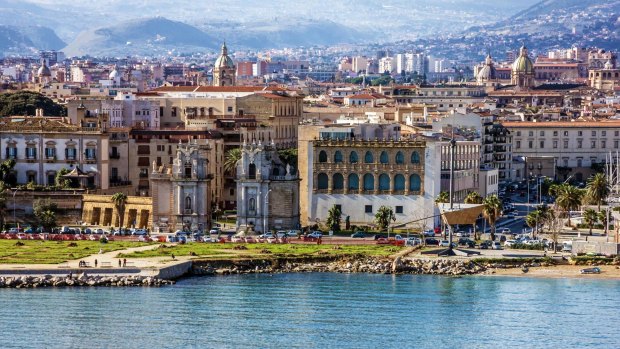
Palermo, Sicily. Credit: Shutterstock
TRAVEL NOTES
Nicholas Whitlam travelled at his own expense.
MORE
FLY
There are no direct flights from Australia to Sicily. Many European cities have direct flights to the two airports, Palermo and Catania: Alitalia, Ryanair and Vueling have hourly flights from Roma and Milan. From Melbourne and Sydney each of Emirates/Qantas, Qatar and Etihad/Virgin have one-stop flights to and from Rome and Milan. Thai also has a one-stop flight to Milan. The more adventurous may consider the train from Rome or Naples to Palermo, Siracusa or Taormina: trenitalia.com
STAY
Belmond Grand Hotel Time, see belmond.com
Hotel Villa Belvedere see villabelvedere.it
San Domenico Palace Hotel, see san-domenico-palace.com/en
Grand Hotel Villa Igiea M Gallery by Sofitel, Palermo, see villa-igiea.com
EAT
Bisso Bistro, see bissobistrot.it
Nicholas Whitlam's latest book Four Weeks One Summer tells how in the summer of 1936, over just four weeks, it all went wrong – for democracy and for Spain, even for the British royals, how politicians failed – and how Hitler, who was hosting the Berlin Olympics, was emboldened to plan a new European war.
Sign up for the Traveller Deals newsletter
Get exclusive travel deals delivered straight to your inbox. Sign up now.